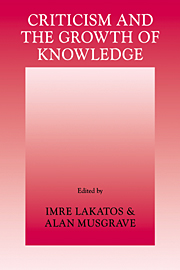 Criticism and the Growth of Knowledge
Criticism and the Growth of Knowledge Book contents
- Frontmatter
- Contents
- Preface
- Note on the Third Impression
- Logic of Discovery or Psychology of Research?
- Against ‘Normal Science’
- Does the Distinction between Normal and Revolutionary Science Hold Water?
- Normal Science, Scientific Revolutions and the History of Science
- Normal Science and its Dangers
- The Nature of a Paradigm
- Falsification and the Methodology of Scientific Research Programmes
- Consolations for the Specialist
- Reflections on my Critics
- Index
- References
Reflections on my Critics
Published online by Cambridge University Press: 05 August 2014
- Frontmatter
- Contents
- Preface
- Note on the Third Impression
- Logic of Discovery or Psychology of Research?
- Against ‘Normal Science’
- Does the Distinction between Normal and Revolutionary Science Hold Water?
- Normal Science, Scientific Revolutions and the History of Science
- Normal Science and its Dangers
- The Nature of a Paradigm
- Falsification and the Methodology of Scientific Research Programmes
- Consolations for the Specialist
- Reflections on my Critics
- Index
- References
Summary
1. Introduction.
2. Methodology: the role of history and sociology.
3. Normal Science: its nature and functions.
4. Normal Science: its retrieval from history.
5. Irrationality and Theory-Choice.
6. Incommensurability and Paradigms.
INTRODUCTION
It is now four years since Professor Watkins and I exchanged mutually impenetrable views at the International Colloquium in the Philosophy of Science held at Bedford College, London. Rereading our contributions together with those that have since accreted to them, I am tempted to posit the existence of two Thomas Kuhns. Kuhn is the author of this essay and of an earlier piece in this volume. He also published in 1962 a book called The Structure of Scientific Revolutions, the one which he and Miss Master-man discuss above. Kuhn is the author of another book with the same title. It is the one here cited repeatedly by Sir Karl Popper as well as by Professors Feyerabend, Lakatos, Toulmin, and Watkins. That both books bear the same title cannot be altogether accidental, for the views they present often overlap and are, in any case, expressed in the same words. But their central concerns are, I conclude, usually very different. As reported by his critics (his original has unfortunately been unavailable to me), Kuhn seems on occasion to make points that subvert essential aspects of the position outlined by his namesake.
Lacking the wit to extend this introductory fantasy, I will instead explain why I have embarked upon it.
- Type
- Chapter
- Information
- Criticism and the Growth of KnowledgeProceedings of the International Colloquium in the Philosophy of Science, London, 1965, pp. 231 - 278Publisher: Cambridge University PressPrint publication year: 1970
References
- 339
- Cited by


